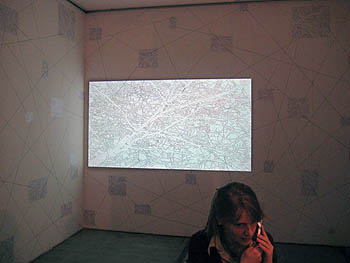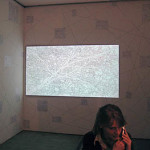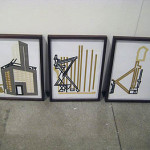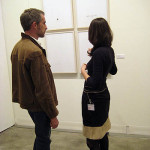By HANNAH COLE
“What do I wear to an art fair in Milan?” This is the question that plagues me the night before my early morning train to Milan for MiArt, one of the largest art fairs in Italy. I am meeting Walter Albertoni, an Italian art collector, to see the fair and discuss what is going on in Italian art today.
Arriving in Milan, I meet Walter. He appears elegant yet inconspicuous, dressed in jeans, a white shirt, and a leather jacket. We say our hellos and enter the fair.
Inside, I am stunned to see that people in general are not dressed up. Here, in Italy, when women go out for lunch on Sunday, they wear heels (in Milan, no less, the fashion capital of the world). When I’ve attended art fairs in Miami and New York, fully one third of the spectacle is the accompanying fashion parade.
No, the big surprise here is that people look normal. The crowd is filled with middle class people from a broad range of ages ‐ parents with strollers, kids, roaming packs of teenagers. They are dressed like it’s Saturday morning, not to see and be seen, but (gasp) to look at the artwork.
The fair itself is made up of three separate pavilions, with a total of 232 booths. Of these, 178 are galleries. As in the Bologna art fair in January, the “emerging” galleries are grouped together in one section within the contemporary galleries. There is less chaos than I expect. Commerce is happening, but not at a frenzied pace.
There is a lot of photography, though perhaps I notice it more because Walter is interested in collecting photography. There is painting, a lot of works on paper, some video, but little installation. In general the work is digestible and saleable – what you would expect at any art fair.
Walter’s attitude is extremely relaxed. There are a few pieces he wants to determine prices for, but mainly he is here to do research. We walk systematically down each row of booths and turn in to the ones that catch his eye. In a third of these, we chat with the gallery attendant.
When we sit for lunch, I ask Walter what makes him interested in collecting art.
“A collector is the curator of his own collection,” he says. We begin to discuss the billionaire French collector Francois Pinault, who upon cancelling plans to build a contemporary art museum outside Paris, instead bought the Palazzo Grassi in Venice to house and display his massive contemporary art collection.
“Pinault has an easy collection,” Walter says. “If I had the money, I would also buy one Damien Hirst, one Jeff Koons. But finding young artists is exciting and more of a challenge.”
I ask him specifically what he finds interesting in the work that he collects. “Society as one brain,” he says. “Maybe you like a piece, it interests you, but maybe you understand it only after ten years.”
He continues, “People say that all art changed after Duchamp. But Duchamp himself ‐ maybe he didn’t understand what he made at the time.” I want to know if Walter thinks that so much history, from the Romans to the Renaissance, is a burden on Italian artists working now.
“No, I don’t think so,” he says. “In Italy, you are living in art, it is a part of you. Like in Greece; they live in philosophy.”
“Italians love color in life – eating good food, drinking good wine, being with friends ‐ and so also in painting and in art. Not only in big cities, but people in small towns and in the country appreciate the color in life.”
At this point, he takes off his jacket. As if to illustrate the point he has just made about history, Walter shows me the label inside. It’s from 1968, his father’s jacket. Walter points out to me all the sections that he’s replaced over the years. The collar was worn completely through, and then relined with corduroy. The shoulders, which had torn at the seams, have been fitted with leather inserts.
“In this pocket,” he says, “I kept the same papers without removing them for ten years. There was a ticket from the subway in Melbourne.”
Perhaps when your high school is next to the ruins of a Roman amphitheater you grow up with a different feeling toward history and culture. Walter’s jacket exemplifies living in the present with history on one’s shoulders.
History and art are just a part of life here. MiArt looks like a fair almost anywhere else. Yet remarkably, it has no feeling of frenzy, no feeling of fad. There are a lot of ordinary‐looking people here taking it in. The gallerists may wish more of them were buying, but to see such a broad range of people unintimidated by contemporary art, to see children and teenagers, is encouraging. This is an informed audience in the making. It is a group of people who will spend time attending museums, perhaps even making art, or like Walter, collecting it. For today, they may only stop for a spritz on their way home, but like Walter, they are appreciating the color in life.
- Above: images of art on display at MiArt; below: Walter Albertoni, collector, speaking with a dealer
"MiArt '08: Milan's International Modern and Contemporary Art Fair was open from April 4th-7th in Milan, Italy.
All images are courtesy of the author.







